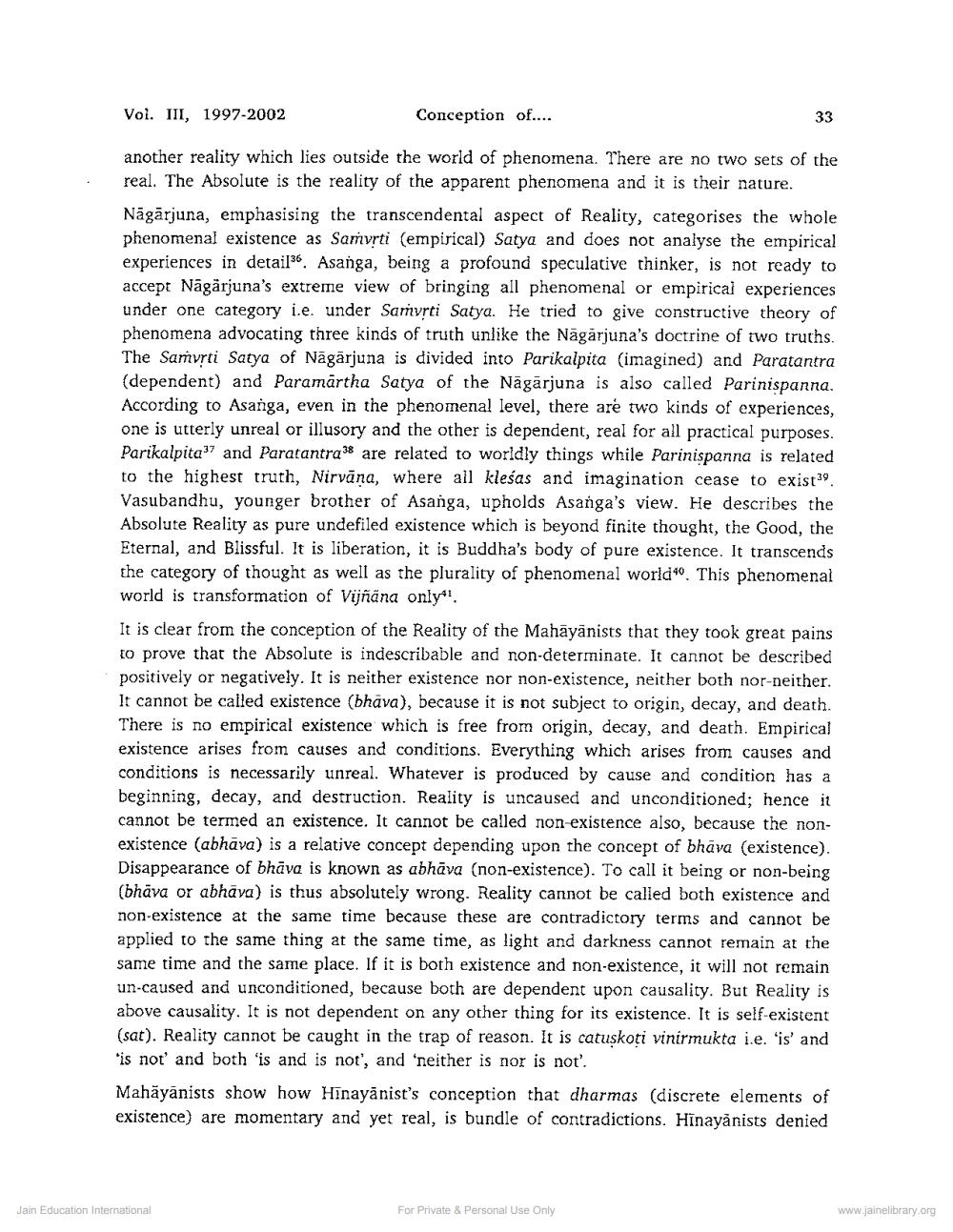Book Title: Conception of Reality in Mahayana Buddhism Author(s): Yajneshwar S Shastri Publisher: Z_Nirgrantha_1_022701.pdf and Nirgrantha_2_022702.pdf and Nirgrantha_3_022703.pdf View full book textPage 8
________________ Vol. III, 1997-2002 Conception of.... 33 another reality which lies outside the world of phenomena. There are no two sets of the real. The Absolute is the reality of the apparent phenomena and it is their nature. Nāgārjuna, emphasising the transcendental aspect of Reality, categorises the whole phenomenal existence as Samvrti (empirical) Satya and does not analyse the empirical experiences in detail. Asanga, being a profound speculative thinker, is not ready to accept Nāgärjuna's extreme view of bringing all phenomenal or empirical experiences under one category i.e. under Samvrti Satya. He tried to give constructive theory of phenomena advocating three kinds of truth unlike the Nagarjuna's doctrine of two truths. The Samvrti Satya of Nagarjuna is divided into Parikalpita (imagined) and Paratantra (dependent) and Paramartha Satya of the Nāgārjuna is also called Parinispanna. According to Asanga, even in the phenomenal level, there are two kinds of experiences, one is utterly unreal or illusory and the other is dependent, real for all practical purposes. Parikalpita37 and Paratantra3% are related to worldly things while Parinispanna is related to the highest truth, Nirvana, where all klešas and imagination cease to exist39. Vasubandhu, younger brother of Asanga, upholds Asanga's view. He describes the Absolute Reality as pure undefiled existence which is beyond finite thought, the Good, the Eternal, and Blissful. It is liberation, it is Buddha's body of pure existence. It transcends the category of thought as well as the plurality of phenomenal world". This phenomenal world is transformation of Vijñana only. It is clear from the conception of the Reality of the Mahāyānists that they took great pains to prove that the Absolute is indescribable and non-determinate. It cannot be described positively or negatively. It is neither existence nor non-existence, neither both nor-neither. It cannot be called existence (bhava), because it is not subject to origin, decay, and death. There is no empirical existence which is free from origin, decay, and death. Empirical existence arises from causes and conditions. Everything which arises from causes and conditions is necessarily unreal. Whatever is produced by cause and condition has a beginning, decay, and destruction. Reality is uncaused and unconditioned; hence it cannot be termed an existence. It cannot be called non-existence also, because the nonexistence (abhāva) is a relative concept depending upon the concept of bhāva (existence). Disappearance of bhāva is known as abhāva (non-existence). To call it being or non-being (bhava or abhava) is thus absolutely wrong. Reality cannot be called both existence and non-existence at the same time because these are contradictory terms and cannot be applied to the same thing at the same time, as light and darkness cannot remain at the same time and the same place. If it is both existence and non-existence, it will not remain un-caused and unconditioned, because both are dependent upon causality. But Reality is above causality. It is not dependent on any other thing for its existence. It is self-existent (sat). Reality cannot be caught in the trap of reason. It is catuskoti vinirmukta i.e. 'is' and 'is nor' and both 'is and is not', and 'neither is nor is not'. Mahāyānists show how Hinayānist's conception that dharmas (discrete elements of existence) are momentary and yet real, is bundle of contradictions. Hinayānists denied Jain Education International For Private & Personal Use Only www.jainelibrary.orgPage Navigation
1 ... 6 7 8 9 10 11
